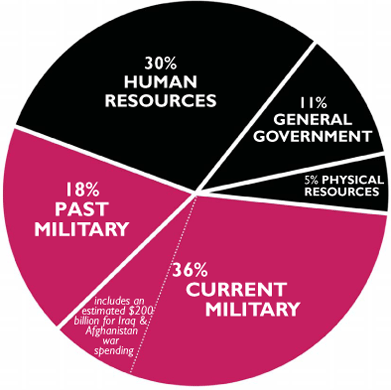 This graph illustrates the essential conundrum of American politics, in my opinion (he added unnecessarily-everything here is my opinion). It's a pictorial representation of the true state of federal budget priorities made plain.
This graph illustrates the essential conundrum of American politics, in my opinion (he added unnecessarily-everything here is my opinion). It's a pictorial representation of the true state of federal budget priorities made plain.
Not shown here is that slice of the budget pie allocated to the "entitlement programs"such as Social Security and Medicare, and there is a reason for this. The Social Security program, for example, is a cash-in, cash-out system that has worked since the Great Depression and would have continued working, had it not been for Congressional embezzlement, until at least 2041. It funds itself through a dedicated system of FICA taxes which have been more than adequate to meet the needs of the retired and disabled; indeed, the surplus built into the system in the early 1980's was designed to create a trust fund that would ensure its future viability. The Congress Clowns, of course, couldn't keep their oversized mitts off the money, and now the system is on the brink of insolvency. (This same Congress, by the way, is the one that you and I are counting on to devise a brilliant plan to rescue the United States from the grips of recession. Yeah, that's going to work.)
And what was Congress doing with the trillions it stole from the Social Security trust fund? The graph above shows you: playing army. If you eliminate that part of the federal budget over which Congress acts as little more than a clearing house for collecting money from working people and sending it to retired people, you are left with about $2.5 trillion in "revenue," consisting of income and other (non-FICA) taxes, the money looted from Social Security and the inevitable borrowing. (Why does the federal government borrow money? Because it can.) 54% of this money is spent on the military and homeland security, one way or another, including that part of the national debt service properly attributable to military spending in the past. We build things like the F-22 bomber, which is essential to our defense against Russian Migs discontinued in the 1980s, but unfortunately can't be used in Iraq because of the sensitivity of its electronics to the garage door openers used by insurgents to detonate IEDs. We build aircraft carriers so it will be a fair fight against the Japanese Imperial Navy if they move on Pearl Harbor again. We build lots of tanks and half-tracks to guard against a land invasion by the Soviet Union through the Fulda Gap in case that East Berlin situation becomes a hot spot again. And so forth.
Does the United States actually need to spend as much as the next 15 largest militaries in the world combined, particularly on the kind of weaponry, ships, tanks, bombs and planes suitable for fighting World War II again? In truth, thermonuclear weapons have made conventional war against other nuclear-armed countries impossible. The United States cannot start a "conventional war" against Russia, for example, on the expectation the war will remain contained. Or, for another example, if you wonder why Syria, Egypt and Jordan never invaded Israel again after the Yom Kippur War of 1973, look no further than the Israeli nuclear arsenal. In the absence of large-scale enemies where it is feasible to use our large-scale military in a conventional war, at least without bringing about the end of human civilization, we have instead embarked on a program of keeping our forces experienced and cutting-edge by fighting unnecessary wars in Vietnam, Grenada, Panama, Somalia, Afghanistan, Iraq, et cetera, and then using these unnecessary wars as the rationale for maintaining a large conventional military in case we need to fight an unnecessary war in the future.
The United States spends well over a trillion dollars per year on defense and homeland security, when you add up the basic Pentagon budget, the "supplementary" appropriations for our vanity wars in Afghanistan and Iraq, the nuclear budget in the Department of Energy, all the espionage agencies (many of them redundant) and the debt service on past budget overruns. No one in a "serious" position in Washington, including Barack Obama, ever talks about reducing military spending to a rational level commensurate with our true security needs.
It is yet another illustration of the complete impotence of the federal government in dealing with real problems. It is locked into ideologies and certain "idees fixes" which it cannot escape, so it begins its confrontation with reality, each and every time, with the result determined in advance.


No comments:
Post a Comment